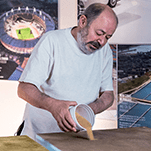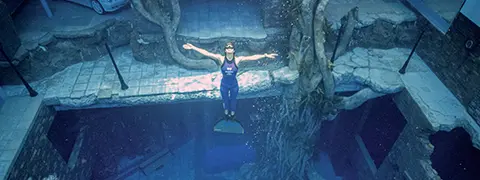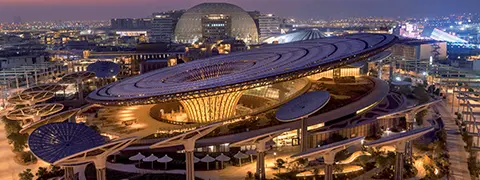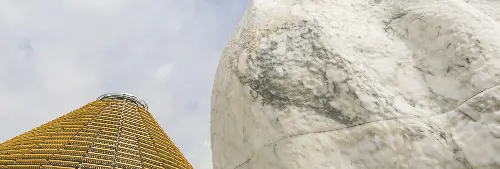
“Metamorphosis”, narrative idea of the project
We spoke with Italo Rota, designer of the Italy Pavilion.
We spoke with Italo Rota, designer of the Italy Pavilion.
The Italy Pavilion for Expo 2020 Dubai uses architecture to stage a creative and innovative presentation of “Beauty connects people”. What were the first choices you made in order to make this idea become visible?
When Carlo Ratti and I stared working on the design of the Italy Pavilion, the first thought that came into our minds was to create a narrative idea of a pavilion in line, on the one hand, with the fundamental concepts of a circular economy, as well as being, on the other hand, a place of innovation. Then, more than a work of architecture, we came up with the idea of a large architectonic installation that arrives and takes shape and is then taken down and leaves. While on this journey it underwent a series of modifications that we could define as a metamorphosis. And to do this we had to think about creating “new materials”, many of them of organic origin, and tackle very particular situations, such as the fact that the pavilion in the visitors’ area is not air conditioned. So we had to pay a lot of attention and be particularly sensitive, which led to the creation of this highly unusual and innovative structure. The concept is of three large boats that arrive in Dubai, are overturned and form the roof. As we all know the word of Latin origin “nave” (in Italian “navata”) actually comes from the fact of turning over a boat. When we say “nave” we mean being together, thinking together, imagining a togetherness and a future to save the planet.
Which of the architectonic and exhibitive elements were designed to provide visitors with a memorable experience?
The story behind the interior is very complex, very rich, and I think visitors will undertake a long journey through Italy of the past, the present and the future. And during their visit, visitors will experience various episodes connected with great technological innovations. In the centre of the pavilion there is an alga factory. Alga became a leitmotif of the pavilion: It produces energy and oxygen because alga “devours” CO2. To accompany this farm, we created a lot of new materials, thanks also to Mapei, using other “remains” of human activity such as coffee grounds and orange peel, as well as other simple components such as desert sand.
If you had to give a synthetic summary of architecture of the future, what should it be like for you? What should be the role of materials and why?
Today, and quite rightly, we often talk about sustainability. I believe we should no longer talk about sustainability in the same way as we have until now because, today, it should be something that comes with common sense. It’s another matter, on the other hand, if we pass to another level, contributing in a more profound way to changing the environment and, above all, to approach the more far-reaching issue of the climate crisis.To do this we must imagine architecture as being not only transformable and reusable but, above all, creating fewer and fewer physical products on the planet. So, we must have materials and technological solutions that transform elements into exchangeable products. I would define it as “architectural banking”; a place where I can take products, exchange them and invest them in exactly the same way as they did before with currency. We also need to have materials that are part of an “urban mine”, from which these products can be extracted with great purity and then transformed. I believe that these two processes together, along with other considerations, can also lead to a reduction in the total constructed mass when producing something new because, one of the problems we have today, is that producing something new also produces a large amount of debris.
Mapei helped make your design choices possible; which ones in particular and how big a part did the company play in achieving the results you expected?
We have been working with Mapei for many years because the innovations this company has developed are perfectly in line with the evolution in architecture in recent years. And also, we have been using Mapei products for years in our projects because they are in step with the evolution in architecture, in terms of both sustainability and long-term innovation. So, when we contacted Mapei for the Italy Pavilion, we proposed working with the materials we had selected when we conceived the idea for the building. Everything went really well and really quickly, which was also due to the fact that materials of this type can only be made by developing prototypes. The work carried out in the Mapei Research & Development laboratories was really interesting and effective.
Can you give us a concrete example of materials developed with the support of Mapei?
For the Italy Pavilion we proposed the use of all five senses during visits: apart from sight and sound, the “classic” senses when visiting a display pavilion, we also added the senses of touch, smell and, in certain areas, taste. For example, we used coffee powder to create, together with Mapei, a very particular material used to coat the first 600 m of the walkway in the pavilion. And this is what turns it into a visit immersed in the fragrance of coffee. Coffee is something that Italy and the Arab countries have in common and creates a moment of almost olfactory brotherhood. Another product we developed together with Mapei was a special coating containing orange powder that is almost like fabric, highly variegated and also fragrant. Another material we created in collaboration with Mapei was made using sand from the Expo site. It forms a sand-dune with an installation made from the same type of sand sitting on it. And here you can see how well the desert blends in, just like it does on the site in Dubai.











